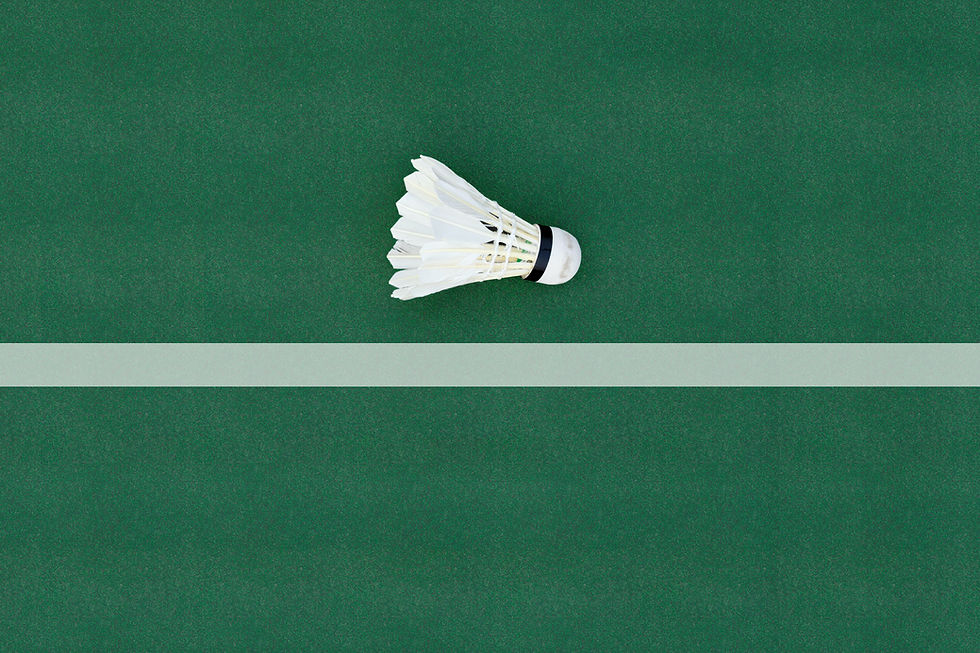Badminton: Safe, Enjoyable Cardio for Heart Health
- Jamie Pickett

- Aug 26
- 5 min read

"Little by little, a little becomes a lot." - Tanzanian Proverb
Who this guide is for
Badminton suits adults rebuilding fitness after a cardiac event, managing cardiovascular risk factors, or simply wanting a lively, social way to move. If you are in cardiac rehab, follow the plan agreed with your clinical team. Doubles play and short, structured rallies are usually the best starting point.
Benefits for heart health
Badminton offers short bursts of movement with built-in pauses, which can be ideal for gradual cardiovascular progression. Expect improvements in aerobic fitness, coordination, balance, leg strength, reaction time, and mood. The smaller court lets you scale distance and pace easily, and doubles helps keep intensity moderate while still enjoyable.
Is it safe for me?
Get medical clearance if you have new or changing cardiac symptoms, uncontrolled blood pressure, or you have recently had a procedure. If you are on heart-rate-modifying medication (e.g., beta-blockers), use the RPE scale and Talk Test alongside heart rate. Begin with light-to-moderate effort and progress gradually under guidance.

Core racquet sports guidance (badminton, tennis, squash)
• Prioritise relaxed technique: exhale gently as you hit to avoid breath-holding.
• Choose doubles over singles initially to reduce court coverage and peak intensity. Keep rallies short (about 6-10 hits), then pause.
• Limit forceful overheads and repeated smashes early on; build shoulder and trunk strength first.
• Avoid prolonged isometric gripping (do not strangle the handle). Use a comfortable grip size to reduce forearm strain.
• Use an extended warm-up and cool-down (8-10 minutes each), especially in colder halls.
• Progress one variable at a time - either session length, rally length, or movement intensity, not all at once.
• Wear court shoes with good lateral support; replace when tread is worn.
• Stop immediately if you feel chest discomfort, unusual breathlessness, dizziness, palpitations, or symptoms that feel cardiac. Seek medical advice.
Prepare and equip
• Racquet: a lighter frame with a comfortable (often slightly larger) grip can reduce forearm and elbow strain.
• Strings: slightly lower string tension softens impact and reduces shock.
• Shuttle: start with a slower shuttle to keep tempo manageable.
• Court setup: begin with half-court or service-box drills to limit running distance.
• Clothing: breathable layers; bring water and consider a small towel to help manage temperature between rallies.

Warm-up (8-10 minutes)
• Easy walk around the court, gradually increasing pace (2 minutes).
• Mobility: neck turns, shoulder circles, trunk rotations, ankle rolls (1-2 minutes).
• Dynamic moves: side step-touch, light marching with arm swings, gentle calf raises (3 minutes).
• Racquet prep: shadow forehand/backhand swings at low effort; gentle split-step footwork to service boxes (2-3 minutes).
How to monitor intensity (Borg RPE 6-20)
Use a combination of heart rate (if prescribed), Borg RPE 6-20, and the Talk Test. Typical rehab targets: Borg 9-11 for easy, 11-13 for light-to-somewhat hard, and up to 12-14 for moderate if advised. Keep speech comfortable in full sentences. Short rallies followed by planned pauses help you stay in range.
"What gets measured gets managed." - Peter Drucker
Technique tips specific to badminton
• Stroke focus: practise smooth clears and gentle drops before faster smashes; share the load between legs, hips, and trunk - do not rely only on the shoulder.
• Footwork: think small steps first, staying balanced with a soft split-step before movement.
• Contact point: meet the shuttle slightly in front of you with relaxed grip pressure that firms briefly on contact.
• Recovery: after each shot, return to a comfortable base position to reduce frantic movement.
Sample sessions (choose one)
Gentle Start (20-30 minutes total)
• Warm-up as above (8-10 minutes).
• Skills block: serving to targets; gentle clears and drops. Work 30-45 seconds, rest 45-60 seconds, 6-8 rounds (Borg 9-11).
• Doubles mini-rallies: half-court, aim for 4-6 hits then pause. Do 6-10 sets with generous rest.
• Cool-down (8-10 minutes).
Build Confidence (30-40 minutes total)
• Warm-up (8-10 minutes).
• Footwork cones or lines: 20-30 seconds on, 30-40 seconds off, 8-10 rounds (Borg 11-13).
• Target rallies: alternate front-court and back-court placements; 60-90 seconds play, 60-90 seconds rest, 6-8 rounds.
• Optional: best-of-five short rallies to 5 points with rests between.
• Cool-down (8-10 minutes).
Push and Recover (40-50 minutes total) - later stages or experienced players
• Warm-up (8-10 minutes).
• Intervals: faster doubles or controlled singles, 45-60 seconds at Borg 12-14, 60-90 seconds rest, 8-12 rounds.
• Placement drill: cross-court clear or drop alternation, 60 seconds on, 60 seconds off, 6-8 rounds.
• Light technical play to finish, keeping form smooth.
• Cool-down (8-10 minutes).

Progression milestones
• You complete the Gentle Start session with steady breathing and no symptoms, and you feel recovered within 24-48 hours.
• You can maintain Borg 11-13 in Build Confidence without form breaking or breath-holding.
• You tolerate brief Borg 12-14 intervals in Push and Recover while staying symptom-free and recovering well by the next day.
Modifications to keep it safe
• Play only doubles or mixed doubles at first; consider half-court.
• Reduce jump shots and overhead smashes; emphasise placement and control.
• Use more frequent rests: one rally on, one rally off.
• Shorten sets if you notice technique breaking down or breath-holding.
• If on beta-blockers, rely more on Borg RPE and the Talk Test than numbers alone.
"When you feel like quitting, remember why you started." - Unknown
Cool-down (8-10 minutes)
• Walk slowly until breathing eases (2-3 minutes).
• Gentle stretches: calves, quads, hips, chest, forearm flexors or extensors, shoulders (hold 15-25 seconds, pain-free).
• Guided breathing: in through the nose 4 seconds, out 6 seconds, for 2-3 minutes.
Warning signs - stop and seek medical advice
• Chest pain or tightness or radiating discomfort; unusual shortness of breath.
• Dizziness, faintness, new palpitations, or a racing heartbeat.
• Excessive fatigue that does not settle with rest, or any symptom that feels different from normal muscle effort.
FAQs
How do I choose between singles and doubles?
Start with doubles to lower the physical load and build confidence. Progress to occasional singles when you can stay in your target Borg range without symptoms and recover well between points.
How often should I play?
Begin with one session per week plus one short skills practice. If recovery is smooth for 24-48 hours, consider building to two sessions per week with at least one full rest day between play days.
Can I strength-train as well?
Yes - two short whole-body sessions per week (bodyweight or light weights) improve shoulder and leg resilience. Avoid breath-holding and long isometric strain. Coordinate with your rehab plan.
What if my heart-rate numbers seem low on medication?
That is common with beta-blockers. Use Borg RPE and the Talk Test to guide effort; numbers can be blunted, but your breathing and ability to talk are reliable cues.
Ready to get started?
My Movement Medicine offers supportive, progressive sessions and one-to-one guidance to help you return to racquet sports safely. For personalised pacing, and help setting your training zones, book a free trial or a one-to-one assessment.
This blog post was written by Jamie Pickett, Clinical Exercise Physiologist, with AI assistance.





Comments